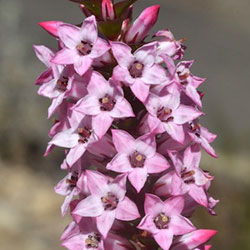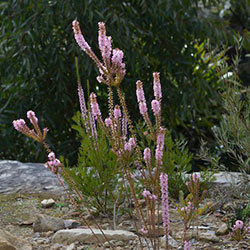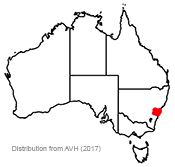Epacris purpurascens
 |
 |
Port Jackson Heath
Epacris purpurascens Banks ex Sims
Epacris purpurascens belongs in the Ericaceae family and subfamily Epacridoideae. The species has two described varieties— Epacris purpurascens var. purpurascens and Epacris purpurascens var. onosmiflora. Epacris purpurascens var. purpurascens is generally found on the central coast around Sydney and between Newcastle and Wollongong while Epacris purpurascens var. onosmiflora is more likely to occur in the Blue Mountains and Lithgow areas.
The species is an erect shrub and in ideal conditions grows to 1.5 m tall and 0.5 m wide. Its stems have leaf scars and the branchlets have long, soft hairs. Concave leaves are pressed close to the stem, curve backwards and taper to a sharply pointed tip. The leaf margin is entire or fringed towards the base.
The flower is a 4.3–7.7 mm long tube and can be white, pink or red. Flowering occurs between July and September along the coast and from October to November on the tablelands. Honeyeaters and other birds are attracted to the flowers but the pollinators are unknown. The capsule is 2–2.5 mm long and contains tiny, dust-like seeds that are dispersed by wind or water.
Epacris purpurascens has ericoid 'hair roots' that form associations with mycorrhizal fungi in the soil. Fungi convert nitrogen and phosphorus into forms that can be taken up by the plant meaning it can exist in harsh, acidic environments and skeletal soils. E. purpurascens grows in dry sclerophyll forests, heathlands, sandstone, swamps, depressions and drainage lines.
Epacris purpurascens tolerates light to moderate frosts and responds well to pruning. It prefers well-drained soils which are moist for most of the year and thrives in partially shady areas. Mimicking its natural habitat (such as building the soil up with rocks) will achieve the best results in the garden. Epacris purpurascens can also be grown in pots.
The most successful propagation method is by cuttings. In late spring (November), cut a non-flowering, green stem which springs back when bent. There is no need to remove the leaves. Dip the cut surface in rooting hormone gel and place into potting mix and sand. Mist regularly and provide bottom heat if possible. A gentle tug on the cutting will tell you if roots have emerged. Aim for minimal root disturbance when transferring the cutting to a larger pot.
Epacris purpurascens var. purpurascens is a vulnerable species in New South Wales under the Threatened Species Conservation Act 1995 (NSW). Habitat clearance due to development, recurrent fire and weed incursion are its greatest threats. There is still much to learn about its ecology and effective conservation strategies. Enabling communities to 'protect their patch' will be instrumental in securing the future of this species in the wild.
Alison Walker, Volunteer Botanical Training Program Participant 2017
Name meaning: Epacris purpurascensEpacris - from the Greek epi, meaning upon, and akris, a summit, referring to high-altitude habitats favoured by some species purpurascens - Latin, meaning 'becoming purple' |
References:
Australian Native Plants Society (Australia) (2017) The Australian heath family – Background. Available at http://anpsa.org.au/epacris1.html [Accessed 11 February 2017].
Barker J., Campbell A., Candy F., McAllister P. and Schaumann M. (2009) Collect and grow that seed – Small Australian plants. Minuteman Press: Thornbury, Vic.
Growing Native Plants (2013) Epacris impressa, Australian National Botanic Gardens. Available at https://www.anbg.gov.au/gnp/interns-2013/epacris-impressa.html [Accessed 7 February 2017].Harden G. J. ed. (1992) The Flora of New South Wales, Vol. 3, University of NSW Press, Sydney.
National Parks and Wildlife Service NSW (2002) Environmental Impact Assessment guidelines – Epacris purpurascens var. purpurascens. Available at http://www.environment.nsw.gov.au/resources/nature/EpurpurascensEia0502.pdf [Accessed 2 February 2017].
Office of Environment and Heritage NSW (n.d.) Saving Our Species program - Epacris purpurascens var. purpurascens. Available at http://www.environment.nsw.gov.au/savingourspeciesapp/project.aspx?ProfileID=10273 [Accessed 2 February 2017].
![An Australian Government Initiative [logo]](/images/austgovt_brown_90px.gif)


